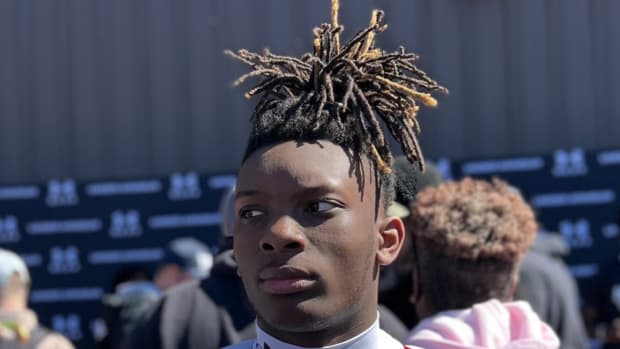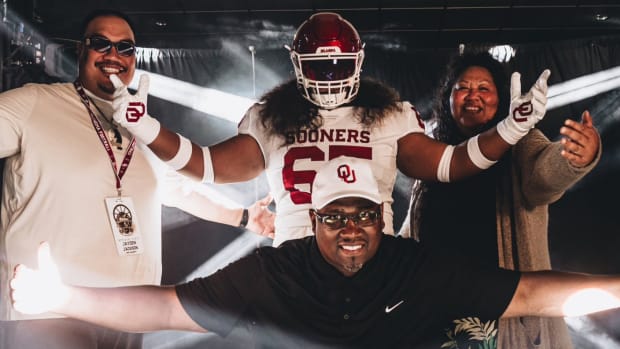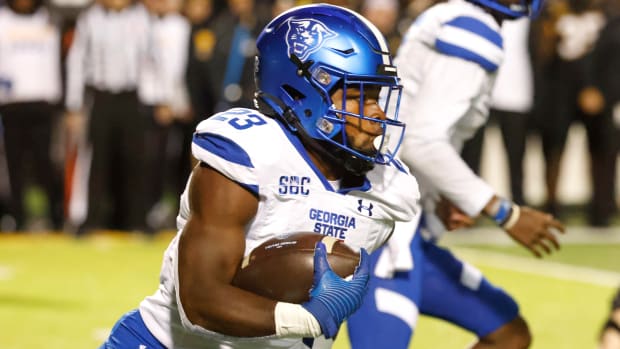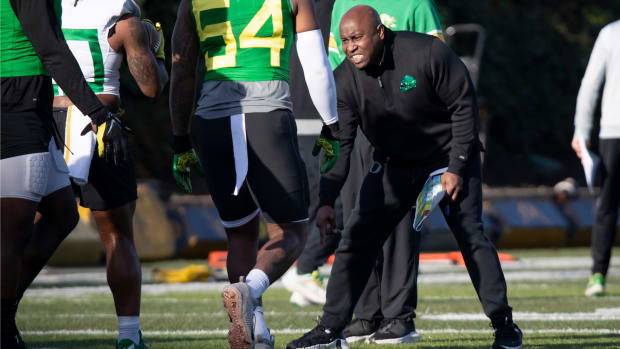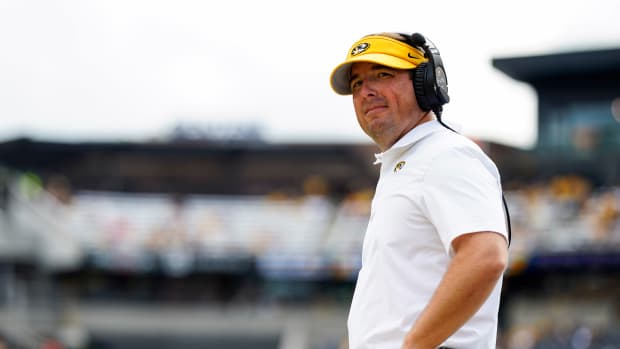Manny Diaz Is Back, but Miami Won't Be the Same
CORAL GABLES, Fla. — As Manny Diaz walked behind one of Miami’s returning players into a recruiting dinner last month, the player spoke up to no one in particular. “I feel like I transferred to a new school,” he said. Behind him, Diaz smiled. “That’s kind of what I wanted to hear,” Miami’s new head coach said.
You have reached your limit of 4 premium articles
Register your email to get 1 more
No team that had a change at the top this offseason would have a better excuse to feel similar to the old regime. After all, Diaz worked in the same building as his current office for the past three seasons. Diaz did take the Temple head coach job for 17 days, but many of those days were spent with Miami’s team because Diaz didn’t want to leave the Hurricanes before their final game in the Pinstripe Bowl. So when Mark Richt abruptly retired on Dec. 30, Diaz could have come in and maintained a steady hand.
But partly out of necessity, partly because of circumstances and mostly because Diaz just thought it needed to be done, the trajectory of the program seems drastically different than it did less than two months ago. The construction in the football complex that will give the players new meeting rooms when they start spring practice was scheduled no matter what, so the place always was going to look different. Diaz wanted to make sure it felt different, too.
Part of that feeling came from the coaching change itself. Diaz’s defense had powered the Hurricanes to an ACC Coastal Division title in 2017—and given the world the Turnover Chain—and had kept Miami afloat as its offense floundered in 2018. But when Wisconsin thrashed Miami 35–3 in the Pinstripe Bowl, there didn’t seem to be a way forward. Diaz was leaving, taking what little positive energy remained on the coaching staff. Richt didn’t seem willing to change much on offense even though the offense didn’t work. The Hurricanes felt stuck.
Then came the announcement.
Miami fans may be mad at Richt because of the way last season went and because of the state of the roster he left behind, but they should understand that few coaches in America would have done for a school what Richt did for his alma mater on the way out the door. He’d already donated his own money to spearhead a project to give the Hurricanes the indoor facility they sorely needed, and by retiring instead of insisting to coach or be fired, he removed several financial impediments to future success. He could have chosen to try to coach his way through a no-win situation, which would have forced Miami to pay him this year and pay him a buyout when he ultimately got fired. Miami is a private school, so Richt’s contract isn’t a matter of public record, but since he received an extension that lasted until 2023 and made about $4 million a year, it’s safe to assume his buyout would have been far more than the $4 million Miami had to pay Temple to buy back Diaz. And remember, had Miami fired Richt after the 2019 season, the school would have had to buy him out and probably would have had to pay a buyout for the coach it hired to replace Richt. The total price tag would have easily pushed into the double-digit millions for a small private school that doesn’t exactly have an overflowing war chest of booster donations.
So while Richt’s tenure ended poorly, it did help check off some of the boxes that other schools used against Miami in recruiting. The Hurricanes have that indoor complex. They’ll soon have a fully refurbished football facility. New dorms are under construction that will house younger players (and at least 51% non-athletes, per NCAA rules). So Diaz will have what his recent predecessors didn’t. That also means he’ll have no built-in excuses if he can’t return the Hurricanes to national prominence. Diaz understands that, but he also believes the taste of success Miami got in a 10-win 2017 should help players understand what is expected going forward. “We think we’re a lot closer to the team that went to Charlotte two years ago,” Diaz says, “than the team that limped off the field at Yankee Stadium a month ago.”
Winners and Losers of the 2019 Class’s Second National Signing Day
Diaz knew he had to work fast to revamp the program to succeed long-term, and the first priority was restoring some sense of class balance on the roster. Want to get your roster out of whack? Change head coaches three years after the last time you changed head coaches. Miami’s fourth-year players either committed to Al Golden or Richt. Miami has only eight seniors on its projected two-deep depth chart, and four of those play linebacker. “When you get put in charge of the entire football team, you go position by position and you evaluate the same thing,” Diaz says. “We’re very young at quarterback. We’re very young at receiver. We’re young on the defensive line.”
After Diaz examined his roster and the Hurricanes’ scholarship situation, he realized he needed to become the Master of the Transfer Portal.
Diaz’s brief departure to Temple hurt Miami’s recruiting in the short term. The Hurricanes only signed 13 players in the early signing period. Most established programs only have two or three spots remaining in their classes after the December period. Miami had 10. Diaz could have tried to find a high school star for every one of those scholarships, but most of the best high schoolers had already signed with other schools. So Miami could have signed a huge class of high schoolers for the sake of signing high schoolers, but they’d find themselves young again down the road. The trick, Diaz says, is to have about the same number of departing players each year to normalize recruiting. So he elected another option. “For the high school kids, the store has sort of been picked clean,” Diaz says. “But there’s this new pool of guys who can help your football team.”
Where are those players? In the portal.
We’re acting as if the transfer portal is something revolutionary because it has a cool name and because many coaches (not Diaz) have complained about it, but all it has done is standardize and nationalize a process that went on behind the scenes every year. Players always transferred between programs, but prior to last year, the players’ current schools could dictate which schools those players transferred to on scholarship. Now they can’t. Players tell the compliance departments at their current schools that they’d like to explore a transfer, and the players’ names appear in the portal—which would sound a lot less interesting if it was called what it is (an online spreadsheet)—within 48 hours. Before, only a few coaching staffs might know a player was on the move. Now they all do.
Miami’s highest profile transfers have been undergraduates. Former Ohio State quarterback Tate Martell and former USC safety Bubba Bolden are the biggest names. But Martell is a sophomore seeking a waiver from the NCAA—which may not come—to play in 2019. Bolden never actually went into the transfer portal because of the odd circumstances of his departure from USC. The transfer recruiting that could pay the most immediate dividends for the Hurricanes came in the portal with players who either have degrees or should get degrees soon.
Diaz already had positive experience with graduate transfers. When he was Louisiana Tech’s defensive coordinator, Louisiana native Houston Bates graduated from Illinois and transferred to Ruston for his final season. Bates, a rush linebacker, led the Bulldogs in tackles for loss in 2014 with 16. When Diaz got to Miami in 2016, the Hurricanes were painfully young in the secondary. Adrian Colbert, a cornerback Diaz had helped recruit to Texas while he was the Longhorns’ defensive coordinator, wasn’t playing much in Austin and wanted a bigger role for his final season. So he reunited with Diaz in Miami. Colbert only played in eight games (starting two) because of injury, but his offseason presence was critical. “We were very young at corner and had issues in our secondary,” Diaz says. “He came in and helped re-establish the culture of how we want our DBs to play.”
In 2017, Dee Delaney graduated from the The Citadel and gave the Hurricanes another experienced corner. Defensive tackle Tito Odenigbo graduated from Illinois and allowed Miami to have an actual defensive tackle rotation in 2018.
STAPLES: Is It Time to Panic About the Willie Taggart Era at Florida State?
As head coach, Diaz started trying to fill holes the same way. Player personnel director Matt Doherty stayed glued to the portal, though he occasionally took breaks and got tipped off by assistants as they perused the portal. Any time he saw a player the Hurricanes might want to pursue, he contacted the relevant position coach and coordinator. “I’ll just run it up the flagpole,” Doherty says. Meanwhile, Doherty tells assistants to keep everything they learn about high school recruits in case those players wind up in the portal in a few years. He said scouting the portal reminds him of the NFL’s pro scouting departments, which evaluate current players for potential trades and free agent signings. “We are all about documentation. I want to make sure that everything a coach says as far as assessment and evaluation of a player is documented and kept on record so we can go back to that,” Doherty says. “Even more than the NFL, you’re dealing with such an enormous volume of players. The evaluation process is relentlessly ongoing.”
The Hurricanes needed help on the interior and exterior of their defensive lines, and the portal helped in both cases. Chigozie Nnoruka started 10 games at defensive tackle for the Bruins in 2017, but he went from an ideal even-front defensive tackle to a too-light nose guard in the 3–4 run by Chip Kelly’s staff. Rising sophomore Jade Silvera is expected to be the star inside on Miami’s line, but Nnoruka should help.
Trevon Hill could play a bigger role. Hill had 20 tackles for loss in two-plus seasons at Virginia Tech, but he was dismissed from the Hokies following a loss to Old Dominion last September. Coach Justin Fuente said it wasn’t one incident that caused Hill’s dismissal, but a reported incident at halftime of that Old Dominion game seems to have been the final straw. A few years ago, Miami took defensive tackle Gerald Willis after Willis was dismissed by Florida. (Willis was dismissed for a variety of reasons, but the last straw was when he hit Florida State quarterback Jameis Winston on the sideline—Willis wasn’t even in the game at the time—and drew a personal foul penalty in 2014.) Willis calmed down at Miami and became one of the Hurricanes’ best players. Diaz hopes the change of scenery can do the same for Hill, who still needs to finish his degree at Virginia Tech this spring to be eligible to play for Miami this season.
NIESEN: Five QB Battles to Keep an Eye on Post-Signing Day
Perhaps the most intriguing graduate transfer the Hurricanes have landed so far is K.J. Osborn, a 6-foot, 205-pound receiver who caught 53 passes for 892 yards and seven touchdowns last season at Buffalo. With Bulls quarterback Tyree Jackson off to the NFL, Osborn sought a higher profile program for his final season. He’ll bolster a sophomore-dominated receiving corps. Diaz wants all those graduate transfers to draw on their experiences and provide some leadership to position groups that might not have had veterans if not for transfers. “These guys have all been at big-time programs. They all know how to work,” Diaz says. “And it’s their last year. And they’re acutely aware that they can’t let a lift or a run or a practice go by without their maximum attention.”
If Diaz and his staff have chosen well, those transfers might join veterans like linebacker Shaq Quarterman as the leaders of a team that could seem completely different even though the names on the roster and the coaching staff didn’t change that much considering how tumultuous the past two months have been. “I wanted them to feel that,” Diaz says. “I wanted them to feel a different energy.”
